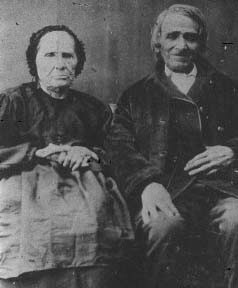Alexis Bidagan dit St. Martin was born on April 18, 1794 at Berthier, just north of Montreal. He used the surname St. Martin all his life, but his formal surname was Bidagan. His first name is pronounced without the silent s: Alexi.In 1822 Alexis St Martin was working as a voyageur for the American Fur Company, in northern Michigan. On June 6 he received an accidental gunshot wound. At close range a musket blast (some say a shotgun) him just under his left breast. Much of his left side was blown away, two ribs were fractured and exposed. His chest and abdomen were opened in several places, and portions of lungs and stomach protruded. His diaphragm was punctured, and a hole now existed directly from his stomach to the outside. St Martin’s breakfast was oozing from the hole when Dr. William Beaumont (1785-1853) arrived.
Dr. Beaumont was as a surgeon in the U.S. Army, and did what he could for St Martin. Dr. Beaumont fully expected St Martin to die within weeks, but St Martin began a miraculous recovery. All his grievous wounds but one healed; that one wound would change medical and scientific thinking.
The wound which didn’t heal was between his stomach and, well, the outside; in medical terms it is a fistula. About the size of a shilling coin, the fistula remained with St Martin for the rest of his 66 years.
Dr. Beaumont used St Martin’s fistula in a series of experiments into the workings of the stomach. Prior to Dr. Beaumont, there were several conflicting theories as to gastric function. Some thinkers thought that heat in the stomach cooked food after you ate it, some thought gears of some sort physically broke down food.
In 1833, Dr. Beaumont used influence to have St. Martin enrolled in the US Army as a Sergeant, St Martin’s only duty to the US Army was to be Dr. Beaumont’s guinea pig.. Also in 1833, Dr. Beaumont published his book, Experiments and Observations on the Gastric Juice and the Physiology of Digestion.
Dr. Beaumont used simple techniques in a number of experiments. In some, he extracted stomach contents from St Martin’s fistula with a (clean, we hope) goose quill. By timing the progress of food through St Martin’s system from mouth to stomach, Dr. Beaumont created a series of diet tables, used by physicians for more than a century. Samples were extracted and sent all over the world for analysis. (Since, in 1830, refrigerated shipping didn’t exist, some samples were rejected at the receiving end.)
Through his series of experiments, Dr. Beaumont was able to establish, in scientific and medical thinking, the true functioning of the stomach: the presence of gastric acids for one. And a French-Canadian voyageur gained a place in medical, scientific, and general history.
Questions were raised at the time as to why Dr. Beaumont never could close St Martin’s fistula. Was he more of a scientist than a doctor? St Martin survived Dr. Beaumont by many years!
In 1879 St. Martin returned (he had resided with Dr. Beaumont in Michigan for some years, but had also travelled a good deal, basically as Dr. Beaumont’s scientific specimen) to St. Thomas de Joliette, very close to his birthplace. Shortly afterward, in one of his letters (written for him, he was, like most North Americans of the time, illiterate), St Martin spoke of desperate poverty. Related letters of the time speak of his family’s poverty, but also of his alcohol consumption.

Alexis St. Martin died, age 86, at St. Thomas de Joliette, Quebec on June 24, 1880, and was buried in the parish cemetery on 28th. St Martin left behind a wife, Marie St. Martin, and several children.
At the service, St Martin’s body was so decomposed that it could not be brought into the church, he was left outside during the service. The family had been plagued by requests from the scientific and medical communities to study their late beloved. Relatives kept the body at home much longer than usual during late June weather; they let it decompose as much as possible so it would be of as little use as possible to science. They also had the grave dug 8 feet deep instead of six, to prevent possible robbing of the corpse.
A plaque has been erected at St Martin’s burial site: in English, it reads:
In Memory of Alexis Bidagan dit St. Martin
Born April 18, 1794 at Berthier
Died June 24, 1880 at St. Thomas
Buried June 28, 1880 in an unmarked grave close by this tablet.
Grievously injured by the accidental discharge of a shotgun on June 6, 1822 at Machillimackinac, Michigan, he made a miraculous recovery under the care of Dr. William Beaumont, Surgeon in the United States Army. After his wounds had healed, he was left with an opening into the stomach and became the subject of Dr. Beaumont’s pioneering work on the physiology of the stomach.
Through his affliction he served all humanity.
Erected by the Canadian Physiological Society, June 1962.
Paul McManus
[…] St. Martin died in Quebec in 1880. His family delayed his burial until his body began to decompose and then buried him in an unmarked grave deeper than normal to prevent his body being dug up for further medical experiments. In 1962, the Canadian government convinced St. Martin’s granddaughter to reveal his burial site, where they gave him a proper ceremony and headstone that read, in part “Through his affliction, he served all of humanity.” […]